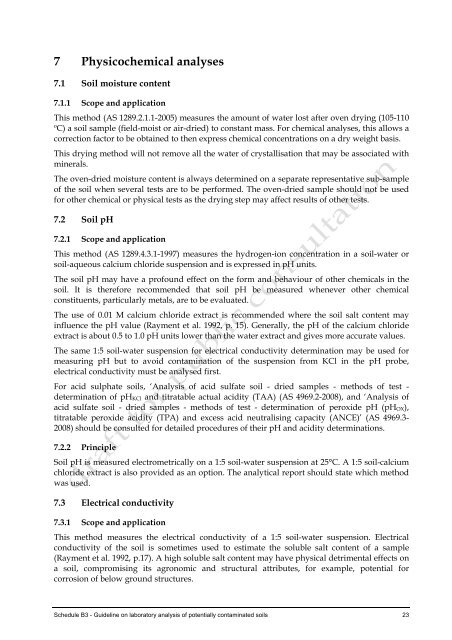Schedule B3 - COAG Standing Council on Environment and Water
Schedule B3 - COAG Standing Council on Environment and Water
Schedule B3 - COAG Standing Council on Environment and Water
- No tags were found...
You also want an ePaper? Increase the reach of your titles
YUMPU automatically turns print PDFs into web optimized ePapers that Google loves.
7 Physicochemical analyses<br />
7.1 Soil moisture c<strong>on</strong>tent<br />
7.1.1 Scope <strong>and</strong> applicati<strong>on</strong><br />
This method (AS 1289.2.1.1-2005) measures the amount of water lost after oven drying (105-110<br />
ºC) a soil sample (field-moist or air-dried) to c<strong>on</strong>stant mass. For chemical analyses, this allows a<br />
correcti<strong>on</strong> factor to be obtained to then express chemical c<strong>on</strong>centrati<strong>on</strong>s <strong>on</strong> a dry weight basis.<br />
This drying method will not remove all the water of crystallisati<strong>on</strong> that may be associated with<br />
minerals.<br />
The oven-dried moisture c<strong>on</strong>tent is always determined <strong>on</strong> a separate representative sub-sample<br />
of the soil when several tests are to be performed. The oven-dried sample should not be used<br />
for other chemical or physical tests as the drying step may affect results of other tests.<br />
7.2 Soil pH<br />
7.2.1 Scope <strong>and</strong> applicati<strong>on</strong><br />
This method (AS 1289.4.3.1-1997) measures the hydrogen-i<strong>on</strong> c<strong>on</strong>centrati<strong>on</strong> in a soil-water or<br />
soil-aqueous calcium chloride suspensi<strong>on</strong> <strong>and</strong> is expressed in pH units.<br />
The soil pH may have a profound effect <strong>on</strong> the form <strong>and</strong> behaviour of other chemicals in the<br />
soil. It is therefore recommended that soil pH be measured whenever other chemical<br />
c<strong>on</strong>stituents, particularly metals, are to be evaluated.<br />
The use of 0.01 M calcium chloride extract is recommended where the soil salt c<strong>on</strong>tent may<br />
influence the pH value (Rayment et al. 1992, p. 15). Generally, the pH of the calcium chloride<br />
extract is about 0.5 to 1.0 pH units lower than the water extract <strong>and</strong> gives more accurate values.<br />
The same 1:5 soil-water suspensi<strong>on</strong> for electrical c<strong>on</strong>ductivity determinati<strong>on</strong> may be used for<br />
measuring pH but to avoid c<strong>on</strong>taminati<strong>on</strong> of the suspensi<strong>on</strong> from KCl in the pH probe,<br />
electrical c<strong>on</strong>ductivity must be analysed first.<br />
For acid sulphate soils, ‘Analysis of acid sulfate soil - dried samples - methods of test -<br />
determinati<strong>on</strong> of pH KCl <strong>and</strong> titratable actual acidity (TAA) (AS 4969.2-2008), <strong>and</strong> ‘Analysis of<br />
acid sulfate soil - dried samples - methods of test - determinati<strong>on</strong> of peroxide pH (pH OX ),<br />
titratable peroxide acidity (TPA) <strong>and</strong> excess acid neutralising capacity (ANCE)’ (AS 4969.3-<br />
2008) should be c<strong>on</strong>sulted for detailed procedures of their pH <strong>and</strong> acidity determinati<strong>on</strong>s.<br />
7.2.2 Principle<br />
Soil pH is measured electrometrically <strong>on</strong> a 1:5 soil-water suspensi<strong>on</strong> at 25°C. A 1:5 soil-calcium<br />
chloride extract is also provided as an opti<strong>on</strong>. The analytical report should state which method<br />
was used.<br />
7.3 Electrical c<strong>on</strong>ductivity<br />
7.3.1 Scope <strong>and</strong> applicati<strong>on</strong><br />
This method measures the electrical c<strong>on</strong>ductivity of a 1:5 soil-water suspensi<strong>on</strong>. Electrical<br />
c<strong>on</strong>ductivity of the soil is sometimes used to estimate the soluble salt c<strong>on</strong>tent of a sample<br />
(Rayment et al. 1992, p.17). A high soluble salt c<strong>on</strong>tent may have physical detrimental effects <strong>on</strong><br />
a soil, compromising its agr<strong>on</strong>omic <strong>and</strong> structural attributes, for example, potential for<br />
corrosi<strong>on</strong> of below ground structures.<br />
<str<strong>on</strong>g>Schedule</str<strong>on</strong>g> <str<strong>on</strong>g>B3</str<strong>on</strong>g> - Guideline <strong>on</strong> laboratory analysis of potentially c<strong>on</strong>taminated soils 23
















